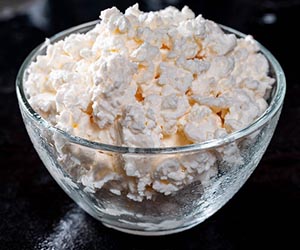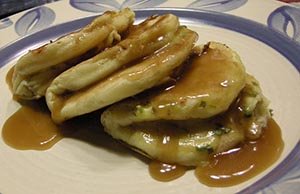Cottage Cheese Nutrition facts
Simple, milky flavored cottage cheese, with its healthy eating image, is one of the most popular varieties of cheese in the United States and is the choice for anyone following a low-fat diet.
The technique of making cottage cheese dates back thousands of years in Europe, wherein traditional herders learned the art of preserving excess skim milk to curdle naturally and then processing it further to soft, bland cheese.
 |
| Fresh cottage cheese. Courtesy: Marco verch |
Preparation of Cottage cheese:
Traditionally, cottage cheese is prepared from pasteurized and skimmed cows milk. The use of clean, sanitized milk utensils is the key to good quality cottage cheese. First, heat the milk to 70°F. Then, add 3 ounces of starter to each gallon of pasteurized skim milk in order to curdle it. Generally, freshly made, cultured buttermilk is employed as a starter. Mix the starter thoroughly in the skim milk by stirring for at least 3 minutes.
Keep the mixture sit for 12 to 14 hours until the curdling process is complete. During setting, certain bacteria in the starter change lactose (milk sugar) into lactic acid, which is a sour compound. When enough lactic acid has been developed in skim milk, it curdles the casein, which is the main protein of milk.
Then, check for the curd, which should be firm and solid and produce a sharp, smooth break. The flavor should be clean and pleasantly sour at this time.
Cut the curd horizontally and vertically into uniform 1/2" cubes so that the finished cheese resembles kernels of popcorn. Allow the curd to sit quietly for 10 minutes. Then, heat the container and gradually increase the temperature of the curd and whey within a period of 1 hour to about 120°. This makes the whey separate rapidly and aids in developing a firm body in the curd. Stir often enough to prevent the curd particles from settling to the bottom and matting together. If properly heated and stirred, the curd particles will retain their original shapes.
Cool the container when the curd granules become firm and meaty. Remove whey and wash curd in cold water repeatedly till all the whey has gone. Then, drain in a colander or through a cheesecloth until the water stops dripping freely for 30 minutes.
Next, to cream and salt the curd, empty it into a bowl, and add about 100g of sweet cream and one teaspoon of salt to taste each pound. Mix the cream and salt thoroughly into the cheese, cover the bowl, and keep refrigerated until used. If good sanitary precautions are used throughout the manufacturing process, the cheese should be kept under refrigeration for 1 to 2 weeks without spoilage.
Health benefits of Cottage cheese
Cottage cheese is one of the nutritious, low-calorie dairy products; carries just 81 cal/100g. It contains 10-15% protein and small amounts of high-calorie fats and sugars. It, therefore, is a quite popular and excellent food for people who are dieting.
It contains good amounts of calcium and phosphorous; and together with vitamin D, cottage cheese ensures sufficient nutrients available for bone growth, especially in children.
It provides high-quality protein that is rich in all essential amino acids required for growth and development and helps stay healthy.
Cottage cheese is a low-lactose dairy product and contains minimal amount of lactose (0.1 g/oz) making it one of the good sources of protein and minerals for those with lactose intolerance. During the curdling process, most of the naturally occurring lactose in milk is converted into more easily digestible lactic acid.
Like other dairy products, cottage is free of gluten. It is, therefore an important source of gluten-free food that is rich in protein, minerals, and vitamins.
It is a healthy food product since most of the constituents in skim milk undergo biochemical changes into more easily digestible and health-benefiting products.
Cottage contains all the vitamins available in the milk, both fat-soluble and B-complex group of vitamins. It is particularly rich in riboflavin and vitamin A (236 IU/100g).
Being soft and fresh cheese, the cottage contains modest levels of minerals, especially calcium (10% of RDI), phosphorus (22% of RDI), and magnesium.
| Principle | Nutrient Value | Percent of RDA |
|---|---|---|
| Energy | 84 Kcal | 4% |
| Carbohydrates | 4.31g | 3.3% |
| Protein | 11g | 20% |
| Total Fat | 2.3g | 11% |
| Dietary Fiber | 0 g | 0% |
| Vitamins | ||
| Folates | 10 μg | 2.5% |
| Niacin | 0.09 mg | <1% |
| Pyridoxine | 0.057 mg | 4% |
| Riboflavin | 0.234 mg | 18% |
| Thiamin | 0.020 mg | 2% |
| Vitamin-A | 230 IU | 7.66% |
| Vitamin-C | 0 mg | 0% |
| Vitamin-D | 0 IU | 0% |
| Vitamin-E | 0.08 mg | <1% |
| Vitamin K | 0 µg | 0% |
| Electrolytes | ||
| Sodium | 321 mg | 21% |
| Potassium | 120 mg | 2.55% |
| Minerals | ||
| Calcium | 103 mg | 10% |
| Copper | 0.033 mg | 4% |
| Iron | 0.13 mg | 1.75% |
| Magnesium | 8.9 mg | 2% |
| Manganese | 0.015 mg | <1% |
| Phosphorus | 148 mg | 22% |
| Zinc | 0.61 mg | 5.5% |
Buying
Fresh cottage cheese is readily available year-round in grocery stores and dairy booths. One can find creamed, large or small curd, nonfat, plain (un-creamed non-salted, with fruit/ vegetables, low fat, lactose-reduced, no sodium added, etc.. in the markets.
Buy fresh cottage cheese in sealed containers/packs from the refrigerated section of stores. Avoid any off-flavored, beyond-date products.
Storing
Like most dairy products, cottage cheese is highly perishable. If you prepare it at home, make small batches frequently and store it well in the fridge for up to a week.
Food uses
Cottage cheese is a wonderful dairy product that is so convenient and versatile to use. You can enjoy it with a little bit of seasoning. It goes well with fruits and vegetables.
Cottage cheese can be used in cooking but is mainly used for making snacks and salads. Salt and a little milk or creams are added and many varieties are flavored. Recipes that call for using cottage cheese are appetizers, muffins, toasts, bread, sandwiches, salads and salad dressings, main dishes, and desserts.
Here are some serving tips
 |
| Cottage cheese pancake (pierogi). Courtesy: Corey taratuta |
Enjoy fresh cottage mixed with a wide variety of foods such as in salads, yogurt, fruits, as a dip, and as a replacement for mayonnaise.
In Germany, cottage cheese is cooked with butter, salt, and sweet cream to prepare cream cheese (Schmierkase, also known as Dutch cheese).
It can be blended with milk to prepare pasta sauce.
Prepare Poland styled stuffed dumplings (pierogi)-served with honey mustard, OR Ukraine style dessert (varenyky) with fillings blueberries, sweet cottage cheese, bilberries and other fruits.
Syrniki (сырники) is a traditional Russian sweet pancake dish made from cottage cheese.
Safety profile
Unlike hard and aged cheeses, the cottage is low in sodium and saturated fats, and therefore, recommended as a healthy dairy product for those who are on a low sodium and fat diet program.
Skim-milk cottage cheese contains small amounts of tyramine and can be eaten in small quantities by those on a tyramine-restricted diet.
Source: Queensland Government-low tyramine diet: MAOI's and diet.
Also read ≻≻-
≺≺ Understanding Lactose Intolerance and How to Manage It
≻≻-Cheddar cheese nutrition facts.
≻≻-Ricotta cheese nutrition facts.
≻≻-Back to Dairy products from Cottage cheese nutrition facts.
≻≻-Back to Home page.
Further Resources:
USDA National Nutrient Database. (opens in new window).
Making cottage cheese in the home. (opens in new window).
Queensland Government- low tyramine diet..